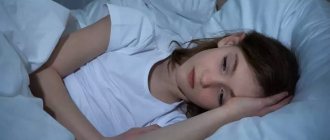Why does an attack of VSD occur?
Vegetative-vascular crisis occurs due to improper functioning of the autonomic nervous system. It is based on a critical situation to which the body reacts by releasing a high concentration of certain biologically active substances into the blood: amino acid derivatives, steroid, protein or peptide hormones. And the manifestations of the crisis depend on which substance will have an effect on the body.
There are many reasons that provoke an attack of VSD. This may be physical or emotional overload, intoxication, disruption of the usual rhythm of life, previous surgery, severe infectious diseases, exposure to medications, weather changes, alcohol intake, premenstrual syndrome, etc.
Vegetative-vascular dystonia: “mysteries” of diagnosis
Over the years, attitudes towards the diagnosis of VSD have changed both among doctors and patients. Together with a neurologist of the highest category, candidate of medical sciences, head of the consultative and diagnostic department of the clinic of the Federal State Budgetary Institution "Research Institute of Therapy and Preventive Medicine" SB RAS Svetlana Duma, we decided to debunk the myths with which this disease is associated today.
Vegetative-vascular dystonia is indeed a fairly new phenomenon. Knowledge of the autonomic nervous system was first developed only in the twentieth century by academician Alexander Wein. However, today 80% of patients who consult a neurologist have a disorder that doctors characterize as vegetative-vascular dystonia. At the same time, the number of such patients is growing rapidly, and antidepressants, which are used to treat VSD, have long taken first place among the best-selling medications. During the short history of its existence, a clear understanding of this disease has not emerged among patients.
Myth 1.
VSD is a vascular disorder.
In fact
This is an imbalance of all organs and systems for the coordination of which the autonomic nervous system is responsible.
According to the definition of Alexander Wein, VSD is a violation of various functions of the body, usually somatic, that is, physically tangible. The cause of these disorders is a failure in the nervous regulation carried out by the autonomic nervous system. It is she who is responsible for synchronizing the processes occurring in the internal organs.
Myth 2.
The cause of VSD is a chronic disease.In fact
Chronic disease can trigger VSD in older people, but in most cases the cause of VSD is a nervous disorder.
Another exception is adolescents whose hormonal levels change during puberty, as well as people with endocrine pathologies. And yet, according to neurologists, only 20% of patients with vegetative-vascular dystonia have a primary pathology of any organ or system.
“In middle-aged and older people, indeed, VSD can develop against the background of some kind of somatic disease
, says Svetlana Duma.
– This could be pathology of the gastrointestinal tract, vascular diseases of the heart or brain, neurodegenerative diseases, consequences of injuries and infections.
But if we talk about the most common cause of VSD, then these are neurotic disorders - anxiety or anxiety combined with depression.” One of the most complex manifestations of VSD, which has developed on a nervous basis, is panic attacks, that is, sudden inexplicable attacks of fear, accompanied by bodily discomfort. As a rule, these symptoms occur when the patient delays treatment of the pathology without recognizing its psychological, or rather psychiatric, nature.
Myth 3.
There is no diagnosis of VSD.In fact
There is such a diagnosis in disease classifiers, but it is not in its “right” place, hence its “non-existence”: the diagnosis is indeed not somatic, but it is not officially classified as a nervous disease.
Since the true cause of most cases of VSD is a disorder of a nervous nature, in the classification of diseases it, logically, should belong to the section of nervous diseases.
However, due to established practice, the diagnosis of VSD is located among somatic (bodily) diseases. According to doctors, the reason for this discrepancy is that patients with vegetative-vascular dystonia are in no hurry to turn to psychiatric specialists.
“If we exclude an organic cause, we diagnose VSD on the background of an anxiety disorder, although the anxiety disorder comes first here
, says Svetlana Duma.
– If such a patient gets to a psychiatrist or psychotherapist, he will be given, in fact, the correct diagnosis. This will be, for example, a somatoform or anxiety disorder, due to which VSD syndrome develops. This bureaucratic discrepancy is apparently due to the fact that people do not want to go to the right doctor.”
Myth 4.
A doctor may miss a serious disease by diagnosing VSD.In fact
The patient is always carefully examined, even if he is “recognized” as a patient with VSD.
The diagnosis of VSD is made by exclusion. This means that when examining a patient with suspected vegetative-vascular dystonia, all possible somatic pathologies are excluded.
“Experienced neurologists immediately see a patient with VSD, but they cannot take upon themselves the responsibility of diagnosing him without additional examinations,
– explains the doctor.
– We look at the probable objective cause that is causing the problem, and if we do not confirm it, we make a diagnosis of “VSD.”
The patient's examinations include a health check according to a certain standard, which includes an ECG and a blood test. In addition, the patient’s endocrine system is checked - the condition of the thyroid gland, pituitary gland, hypothalamus and adrenal glands.
Myth 5.
VSD is the second name for another disease.In fact
Other names for VSD are related to the fact that at one time they tried to rename this diagnosis, but now it has no official synonyms.
“We have a variant of the diagnosis that, in general, has become obsolete - neurocirculatory dystonia
, says Svetlana Duma.
– It implies slight fluctuations in pressure, minor rhythm disturbances. Now this diagnosis is not made; instead, VSD is given. They tried to rename VSD, for example, there was a syndrome of vegetative dystonia, Alexander Moiseevich Vein proposed “psycho-vegetative syndrome.” The name may vary, but the classification remains “VSD”.
Myth 6.
Symptoms of VSD are concentrated in the head area.In fact
Symptoms can manifest themselves both from the gastrointestinal tract and as pain in the chest.
Neurologists call VSD a multisystem diagnosis: the disorder attacks the patient from an unexpected direction, and sometimes from several sides at once. A patient with VSD may complain, for example, of pain in the heart area, but when questioning the doctor, it turns out that he has been tormented by intestinal problems for a long time, chills appear inappropriately, and sometimes his body temperature fluctuates.
“Very often, patients with VSD complain of pain, from different sides. One of the variants of autonomic dysregulation is functional disorders of the gastrointestinal tract,
— says Svetlana Duma.
– In recent years, they have been encountered so often that gastroenterologists have identified them as a separate category. In the 19th century, these disorders were called intestinal neurosis; now they are functional disorders of the gastrointestinal tract.”
Myth 7.
VSD is a congenital pathology, and at the same time “lifelong”.In fact
VSD is usually acquired in a stressful situation, and it is possible to get rid of dystonia with proper treatment.
According to the doctor, the success of treatment depends on individual “brain chemistry.” As a rule, treatment is quite long, but it does not last for the rest of your life. At the same time, the disease can catch a person, as they say, out of the blue, because almost everyone is exposed to stress today. But it is a stressful situation that often becomes a trigger for symptoms of VSD.
“In the 90s in Novosibirsk there were small echoes of the earthquake, to which many residents reacted with fear and deterioration in health,
- the doctor recalls.
– Then a whole layer of so-called vegetatives went to neurologists.
Sometimes in a stressful situation a person mobilizes and copes with the problem, sometimes very successfully. Often after such situations an anxiety disorder occurs because the body is overstressed and is unable to relax.” How to treat?
Unfortunately, a patient with VSD due to a nervous disorder today is in a difficult situation. On the one hand, he should contact a psychiatrist, but specialists in mental illness, as a rule, do not find sufficient grounds for treatment. The services of their alternative, psychotherapists, are usually not cheap. However, in not very advanced cases, patients with a disorder of the autonomic system can be helped by a neurologist or therapist. According to the doctor, it is they who see the vast majority of such patients.
“In Soviet times, therapists were turned into psychotherapists, but now, of course, there is no such thing,
– says Svetlana Duma.
“ But today a therapist can prescribe first-line antidepressants, which are allowed for everyone.
In this case, it is the nervous disease that needs to be treated – anxiety or anxiety-depressive disorder. We can prescribe mild medications that stabilize autonomic activity, but if the nervous disorder is not treated, after some time all the symptoms will return.”
Prevention of vegetative-vascular dystonia
But prevention of nervous VSD is simple. If it is hardly possible to protect yourself from stress in modern conditions, then everyone can prevent nervous overexertion, the doctor assures. To do this, you just need to set aside some time for rest every day and during the week.
“The body is like a spring; if you constantly strain it, it will react in the form of imbalance,” says Svetlana Duma. – It is also important to learn to enjoy the little things. If a person knows how to have fun every day, that’s great – it improves his health.”
Related articles:
Under the pressure of depression
Panic attacks: silent horror
How to prevent or stop an attack of VSD
If you want to prevent an attack of VSD or get out of it with the least loss to the body, you need to analyze and, if possible, eliminate the conditions that provoke the development of this condition.
If the cause is fear, severe emotional shock or another external irritant, you need to try to take control of your emotions, think about something distracted, close your eyes, massage your eyelids. To stop an attack of VSD, it is also worth providing an influx of fresh air (open a window, unbutton a collar, or get rid of items of clothing that impede breathing). To improve cerebral circulation, you should lie down or at least take a comfortable sitting position.
To cope with an attack of migraine-like VSD, you need to go to a quiet place where there is no bright light. If your blood pressure increases or decreases, it is recommended to take the appropriate medication. A hot foot bath or a warm blanket will help overcome chills. In addition, at the first sign of an approaching panic attack, it is recommended to eat something sweet and drink a glass of water in slow sips.
Since it is not always possible to relieve an attack of VSD on your own, experts recommend taking a sedative.
Without professional medical help, panic attacks can become more frequent, gaining strength each time. Therefore, people prone to repeated exacerbations should definitely visit a neurologist. An experienced doctor will be able to advise how to get rid of an attack of VSD, select the optimal treatment regimen and tell you what to do during the next vegetative-vascular crisis.
How to treat vascular dystonia
VSD may not manifest itself for a long time, but under certain conditions it occurs again, bringing discomfort to my patients. During the appointment, I try to explain in detail how you can strengthen the vascular response to stress.
Depending on the symptoms of VSD, I recommend:
- physical education at home or sports under the supervision of professional trainers are the most important helpers in the fight against dystonia;
- normalization of sleep and wakefulness (sleep at least 8 hours);
- diet: exclude provoking foods (coffee, alcohol, fried, fatty foods), add vegetables and fruits rich in vitamins and potassium salts to the diet;
- massage courses;
- herbal medicine - the aromas of mint, apricot, almond, lavender have soothing properties;
- psychotherapy (the psychosomatic model of dystonia was neither refuted nor confirmed);
- Spa treatment.
If the condition does not improve, they resort to drug treatment. Pharmacies offer a large selection of drugs that patients like to prescribe for themselves, without doctor’s recommendations, which always upsets me. An individually selected drug, taking into account the nature of dystonia, will definitely have an effect.
What pills do I recommend to my patients to combat VSD:
- Antidepressants are the drugs of choice No. 1; they work great for VSD.
- Nootropic drugs – improve energy metabolism in brain cells. Many patients buy drugs whose effectiveness has not been proven, for example, Eltacin (we often have disputes with them about the advisability of its use in vegetative crises). This dietary supplement contains the amino acids glycine, glutamic acid and cystine. In some cases, I consider it as a preventative measure.
- Anxiolytics, or tranquilizers, have a relaxing effect, relieve feelings of fear, anxiety, anxiety, but have side effects - drowsiness, slow reactions, memory loss, etc. For patients with VSD without crises, I recommend taking Afobazol. "Phenozepam" is a stronger drug, so it is preferable to take it under the supervision of a physician.
- I prescribe angioprotectors to normalize cerebral circulation.
- Antioxidants improve stress resistance. I recommend Mexidol if the metabolic processes of the brain and blood circulation are disrupted. During my work, patients did not complain of side effects.
As a doctor, I am skeptical about homeopathic medicines - due to the lack of a sufficient number of studies that would show their effectiveness in VSD.
The main thing with VSD is prevention. You can forget about your ailments for a long time and live a full life. If you strictly follow all the recommendations for combating dystonia, it will recede for many months and even years. If you still have questions regarding this syndrome, we recommend watching the video located below the link. Briefly, accessiblely and professionally about symptoms, diagnosis and treatment from the experts of our portal. Enjoy watching!
Doctor's advice: how to live with VSD and what you should limit yourself to
- Try to avoid stressful situations.
- If possible, normalize daytime activity and nighttime sleep.
- Exercise at least 2 times a week
- If you feel an attack approaching, try to relax, if possible, lie down. If the sensations intensify, consult your doctor; adjustments in treatment or recommendations may be necessary.
- If a consultation with a psychotherapist or psychiatrist is recommended, do not refuse, visit a doctor; in many cases, this particular specialist will help you understand your conditions and prescribe effective treatment.
Measures to prevent attacks of VSD
Unfortunately, a universal panacea to overcome an attack of VSD has not yet been found. To cope with this problem, a person should completely reconsider his usual lifestyle.
First of all, it is necessary to eliminate nervous overload, establish a work and rest schedule and change your diet, giving preference to foods rich in potassium and magnesium. You need to sleep in a well-ventilated area and at least 8 hours a day. It is worth reducing the amount of time you spend in front of a TV screen or computer monitor. If this is not possible due to the nature of your professional activity, you must take breaks, setting aside time for rest and physical activity during the day.
Daily walks in the fresh air, cycling, jogging, and aerobics are very useful. And, of course, it is necessary to put an end to bad habits that can worsen the course of the disease - smoking, excessive alcohol consumption, etc.








